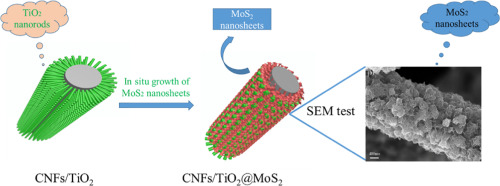当前位置:
X-MOL 学术
›
Mater. Des.
›
论文详情
Our official English website, www.x-mol.net, welcomes your
feedback! (Note: you will need to create a separate account there.)
3D hierarchical carbon nanofibers/TiO2@MoS2 core-shell heterostructures by electrospinning, hydrothermal and in-situ growth for flexible electrode materials
Materials & Design ( IF 7.6 ) Pub Date : 2020-04-01 , DOI: 10.1016/j.matdes.2020.108503 Fang Lu , Jinguang Wang , Xiaoling Sun , Zhenjun Chang
Materials & Design ( IF 7.6 ) Pub Date : 2020-04-01 , DOI: 10.1016/j.matdes.2020.108503 Fang Lu , Jinguang Wang , Xiaoling Sun , Zhenjun Chang

|
Abstract Design and synthesis of unique core-shell heterostructures for flexible electrode materials have recently attracted intensive attention. In this work, 3D flexible carbon nanofibers (CNFs)/TiO2@MoS2 core-shell hierarchical nanostructures were prepared on the surface of CNFs by combining electrospinning, hydrothermal method and in situ growth. We investigated the behavior of CNFs/TiO2@MoS2 as electrode material, which showed desirable electrochemical performance in terms of ultrahigh specific capacitance and long-term stability. The CNFs/TiO2@MoS2 exhibited ultrahigh specific capacitance (510.4 F g−1 at 0.5 A g−1) superior to CNFs/TiO2 (53.8 F g−1 at 0.5 A g−1) and prominent rate capability at high scan rates. Specifically, the capacitance retention of CNFs/TiO2@MoS2 remained about 95.7% even after 3000 cycles at 3.5 A g−1, which indicates considerable cycling stability. Hence, this work presents a novel strategy for the construction of cost-effective, flexible and high-performance 3D electrode materials, and confers in-depth understanding of nanocomposites with relatively light quality. The fabricated nanocomposite can have attractive application prospects in energy storage systems and can even be extended to wearable and portable energy storage equipment.
中文翻译:

通过静电纺丝、水热和原位生长制备柔性电极材料的 3D 分层碳纳米纤维/TiO2@MoS2 核壳异质结构
摘要 用于柔性电极材料的独特核壳异质结构的设计和合成最近引起了广泛关注。在这项工作中,通过结合静电纺丝、水热法和原位生长,在 CNFs 表面制备了 3D 柔性碳纳米纤维(CNFs)/TiO2@MoS2 核壳分层纳米结构。我们研究了 CNFs/TiO2@MoS2 作为电极材料的行为,在超高比电容和长期稳定性方面表现出理想的电化学性能。CNFs/TiO2@MoS2 表现出超高的比电容(0.5 A g-1 时为 510.4 F g-1),优于 CNFs/TiO2(0.5 A g-1 时为 53.8 F g-1),并且在高扫描速率下具有显着的倍率能力。具体而言,即使在 3.5 A g-1 下循环 3000 次后,CNFs/TiO2@MoS2 的电容保持率仍保持在 95.7% 左右,这表明相当大的循环稳定性。因此,这项工作提出了一种构建具有成本效益、灵活和高性能的 3D 电极材料的新策略,并有助于深入了解质量相对较轻的纳米复合材料。所制备的纳米复合材料在储能系统中具有诱人的应用前景,甚至可以扩展到可穿戴和便携式储能设备。
更新日期:2020-04-01
中文翻译:

通过静电纺丝、水热和原位生长制备柔性电极材料的 3D 分层碳纳米纤维/TiO2@MoS2 核壳异质结构
摘要 用于柔性电极材料的独特核壳异质结构的设计和合成最近引起了广泛关注。在这项工作中,通过结合静电纺丝、水热法和原位生长,在 CNFs 表面制备了 3D 柔性碳纳米纤维(CNFs)/TiO2@MoS2 核壳分层纳米结构。我们研究了 CNFs/TiO2@MoS2 作为电极材料的行为,在超高比电容和长期稳定性方面表现出理想的电化学性能。CNFs/TiO2@MoS2 表现出超高的比电容(0.5 A g-1 时为 510.4 F g-1),优于 CNFs/TiO2(0.5 A g-1 时为 53.8 F g-1),并且在高扫描速率下具有显着的倍率能力。具体而言,即使在 3.5 A g-1 下循环 3000 次后,CNFs/TiO2@MoS2 的电容保持率仍保持在 95.7% 左右,这表明相当大的循环稳定性。因此,这项工作提出了一种构建具有成本效益、灵活和高性能的 3D 电极材料的新策略,并有助于深入了解质量相对较轻的纳米复合材料。所制备的纳米复合材料在储能系统中具有诱人的应用前景,甚至可以扩展到可穿戴和便携式储能设备。











































 京公网安备 11010802027423号
京公网安备 11010802027423号